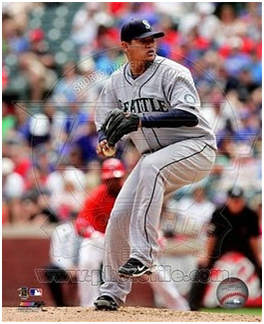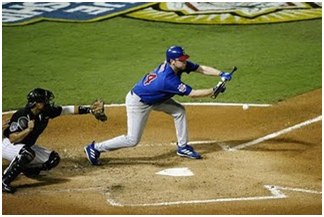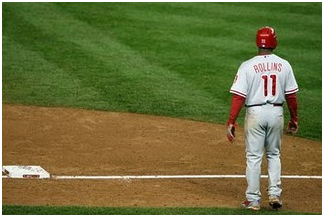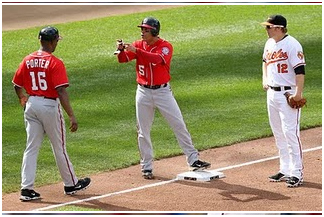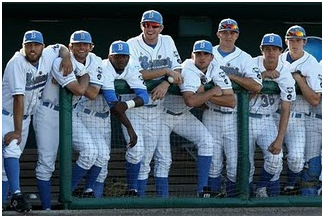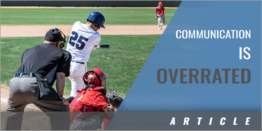|
By: Bob McCreary - Baseball by the Yard I mentioned in Part 1 that I believe the suicide squeeze to be a great weapon for an offense because it is almost impossible to defend against once the play is in motion. The biggest reason for this is the timing involved. If both the runner and the batter time their actions properly, all the defense will be able to do is just hope the batter misses the pitch, pops it up, or bunts it foul. The importance of the timing involved is why I have dedicated a separate part just on this aspect of the suicide squeeze.
When it comes to the timing of the play, the key is to start putting everything into motion at a time at which the defense is unable to alter their actions. Start the process too early and the defense will have more time to react and defend the play. Start too late and both the batter and runner will have a tougher time accomplishing their responsibilities. Timing the play properly all starts with watching the pitcher and putting things into motion at some pre-defined spot in the pitcher's delivery. Coaches may differ on what they want their players to key on but the point is the same. Pick a spot in the pitcher's delivery where once he gets to that spot, he will be unable to alter his pitch to home plate. Here is the rule that I teach my players: At this point in the pitcher's delivery he is committed to throwing whatever pitch was called for. He will be unable to change his grip or the location of the pitch. If a runner takes off or if the batter squares prior to the hands separating, the pitcher will have more time to take those actions to try and prevent the squeeze from being successful. Starting too long after the hands separate will make it easier for the defense to field the bunt and cut down the runner trying to score. This is because the runner will be farther from home plate when the ball is bunted. Starting too late usually doesn't provide the batter enough time to get into the proper bunting position as well. When it comes to the timing involved, players almost never start too late. The opposite is usually the case. The pressure to perform in this do-or-die play usually results in an increase in anxiety for both the runner and the batter. From the time the signal is given to the time to ball is bunted, both hearts are beating a mile a minute. This usually causes either the runner or the batter (or both!) to "jump the gun" and start the play too soon. Frequently practicing the timing of the suicide squeeze is essential to getting the players involved to keep their emotions under control and adhere to the proper timing needed for success. The suicide squeeze - Part 4: The mechanics
Although the squeeze play is hard to defend against once it has been properly put into motion, the batter still has to get the bunt down and the runner still has to travel 90 feet to score. Easier said than done. Except for the timing of when to square to bunt as explained in Part 3, basic rules for how to properly sacrifice bunt apply to the suicide squeeze. Instead of listing all the basic fundamentals of sacrifice bunting here, I'll refer you to a couple previous posts that covered some of those details. They are as follows: Sacrifice bunting - square up for success There are, however, a few bunting and base running tips that apply specifically to the success of the squeeze play. This part of the series is dedicated to those. Tips for the batter: Pivot, don't square In the two previous posts linked above, I offered a couple of options when squaring to bunt. On a normal sacrifice bunt, some coaches want their players to completely square around so that their entire body - including their feet - is square to the pitcher. Others would rather have their hitters just pivot. Both options have merit. However, during a squeeze bunt, the batter should pivot as opposed to squaring all the way around. As you read in Part 3, timing is very important on a squeeze play. Pivoting instead of squaring around takes less time and keeps the element of surprise intact a bit longer.
Keep it away from the pitcher and catcher If the timing is right, the only players that realistically have a chance to field a squeeze bunt and make a play at home plate are the pitcher and the catcher. That's why a batter should do everything to NOT bunt it hard right back to the pitcher or too soft so that the catcher fields it right in front of the plate. If the batter bunts it away from home plate and makes the pitcher go left or right, it works virtually every time. Bunt it where it's pitched There is no rule as to which side of the field the ball should be bunted towards. Basic rules of hitting apply. If the pitch is on the outer half, bunt it to the opposite side of the field. If the ball is on the inner half, bunt it to the pull side of the field. If the pitch is a poor one (very high, very low, etc.) the batter should just do the best he can to bunt the ball in play. Look away and adjust inside This phrase is a popular one for hitters with two strikes. That's because it keeps their weight back and gives them better plate coverage. The same thing applies to the suicide squeeze. It is always easier to prepare for a pitch on the outer half and then adjust to an inside one than it is to look inside and have to adjust to an outside pitch. Tips for the runner: Take your normal lead Nothing changes on a squeeze play in terms of a runner's lead. Anything other than a normal lead off third base and the other team might suspect something.
Use a walking lead This tip only applies to a pitcher in the wind-up or if a pitcher in the stretch has a big leg kick. A pitcher in the wind-up will take a second or two to get to the spot in his delivery where he separates his hands. In this situation, the runner should start walking down the line when the pitcher starts his wind-up and then turn it into a sprint when the pitcher separates his hands. This normal, walking lead forces the runner to not leave too early and also cuts the distance of his run home when he starts to sprint. For the same reasons, the runner should do this when a pitcher has a big leg kick from the stretch. The runner just won't be able to get as far down the line before turning on the speed. A pitcher who slide steps with a runner on third poses more of a challenge for the runner. In this case it may be necessary for the runner to take a slightly larger lead off third to start in order to compensate for not being able to take a walking lead on the pitcher's delivery. The Suicide Squeeze - Part 5: Defending the squeeze play As I have stated numerous times in this series on the suicide squeeze, if the offensive team hides it well, uses the proper timing, and executes the fundamentals of the bunt, there is virtually nothing a defense can do to stop the suicide squeeze. Therefore, defending the squeeze play basically involves taking advantage of any mistake the offensive team makes during the process. Defending the squeeze involves many people but the major players are the pitcher, catcher, 1st baseman, and the 3rd baseman. This last part of the Suicide Squeeze series will focus on each separately and conclude with another very profitable tip for the team on defense.
The Pitcher The first tip for all pitchers involves peaking at the runner at third prior to the pitch. Click HERE to read a previous post for more details on this topic. When it comes to a pitcher's delivery, it is generally a good idea to go from the stretch position with less than two outs and a runner on 3rd base. I mentioned in Part 4 that a runner at 3rd has a more difficult time getting a good jump towards home plate when a pitcher is in the stretch. However, when a pitcher goes from the wind-up, a runner may be too anxious and leave too early. The wind-up gives the pitcher more time to adjust his pitch if this occurs. Should the batter or runner tip off the squeeze too early the pitcher has a couple options. First, the pitch can be thrown in a pre-determined location like up and away or even a normal pitch out location. The key is that both the pitcher and the catcher have to know beforehand where the pitch will be thrown. The second option poses an ethical dilemma that involves throwing at the batter. Should the pitch hit the batter, a dead ball is the result and the runner will have to go back to third base. You would normally only see this strategy if the runner on third is the game-winning run. It goes without saying that there is a significant danger in telling a pitcher to take this option. Should a batter get seriously hurt and it comes out that the coach instructed his pitcher to purposely hit the batter, the coach can understandably be in a world of trouble. I am not condoning this play. I'm simply stating that it has been used as an option. Fielding a squeeze bunt and tossing it to the catcher is obviously an important responsibility for any pitcher. PFP (Pitchers Fielding Practice) should include drills that help prepare pitchers to do this properly. The Catcher Much of what the catcher does involves looking for clues as to when it may be coming. Observing the batter is his priority. Watching for changes like where the batter positions his feet in the box or how the batter acts after he gets the sign from the third base coach would be a catcher's responsibility. The 1st Baseman Like any bunt situation, the first baseman's job is to charge towards home plate when able and hopefully be in a position to make a play at home on a poorly bunted ball.
The 3rd Baseman The role of the third baseman is similar to the first baseman in that when the play is identified, he charges towards home plate. However, there is something else the third baseman can do prior to the pitch. Many times a third base coach will talk to the runner at third before and/or after the sign is given to insure that he knows the squeeze is on. As a result, it's not a bad idea for the third baseman to wonder over towards the third base bag before each pitch in an effort to hear what the coach is saying. There is nothing unethical about this. The third baseman can go anywhere he wants as long as he is not interfering with the runner.
Final Tips In this series, a lot of attention has been given to watching the third base coach, the runner at third, and the batter for clues that a squeeze might be coming. That being said, there is another area that should be watched. The offensive team's bench. In my experience, I believe this to be the most profitable area to watch. The major players involved in the squeeze play - the third base coach, the runner, and the batter - basically know that they are being watched and normally conduct themselves accordingly. However, players on the bench sometimes make the mistake of assuming that nobody is watching them. Personally, I don't spend much time trying to decipher signs from the third base coach. I usually just watch the other teams' bench and look for anything out of the norm. To follow what's happening in the game, many players on the bench pay attention to the signs given by the third base coach. Players who all of a sudden become very alert after the sign is given may be indicating that a play is about to occur. You may see a bench player elbow a kid next to him as if to say "Pay attention. The squeeze is on." An on-deck batter may stop his routine so that he can watch what is about to occur. There are many variations. The key is to watch them throughout the game so you can pick up their normal behaviors. You can then compare that with what you see in big situations later in the game and hopefully pick up anything out of the ordinary. The suicide squeeze can be a valuable play for any offense. Practicing it and paying attention to the many little things involved can pay dividends for both the offensive and defensive teams. About the Author... I am proud to come from a baseball family. My grandfather's (Mother's side) name was Hal Kelleher. He pitched for the Philadelphia Phillies in the 1930's. My father was a long time baseball coach at the youth, high school, and college levels. He even had a chance to coach in the College World Series while an assistant at Temple University in 1972. While in the military service, my father was stationed at Fort McPherson outside of Atlanta, Georgia which had a general that was a baseball fanatic. He did everything he could to bring major league players who were drafted into the Army to Fort McPherson. As a result, Fort McPherson was stacked and won the All-Army Championship as a result. My father played second base on that team. Being around those major leaguers was quite a learning experience for my Dad. He learned about the mental toughness of major leaguers and all the finer points that made them tremendous players. Because of all this, from the time I picked up a baseball, I was learning the finer points of the game. Many of the things I was learning at a young age are not generally taught to players until they get into the higher levels. I was very fortunate to have those good baseball people close to me. When I finished my playing career, I decided I wanted to pass on these finer points to as many players, coaches, and parents as I could. My coaching, this website, and especially my blog are all an attempt to do that. I hope you enjoy what I have to offer. If you are a player or coach, I hope that something you learn from me gives you a better chance at playing and/or coaching at the levels I have been fortunate to experience. Best of luck to all of you on your baseball journey! Bob McCreary |




